




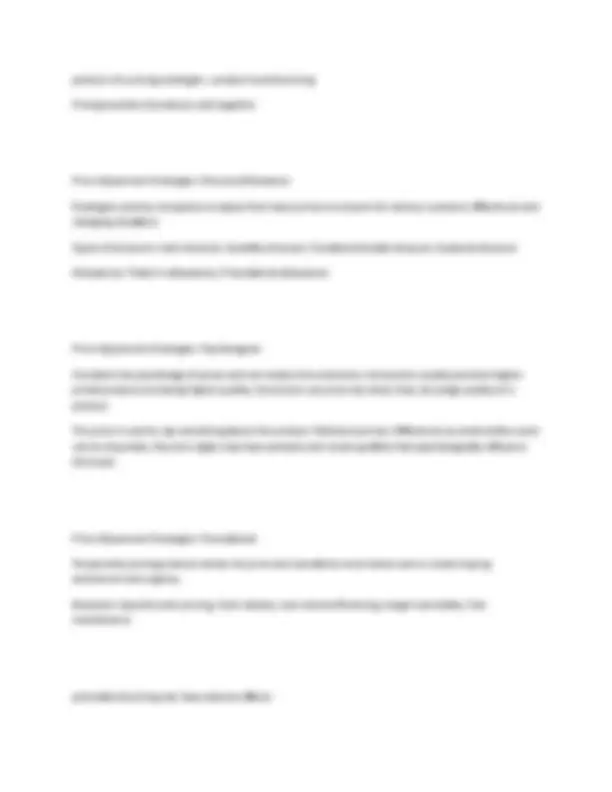

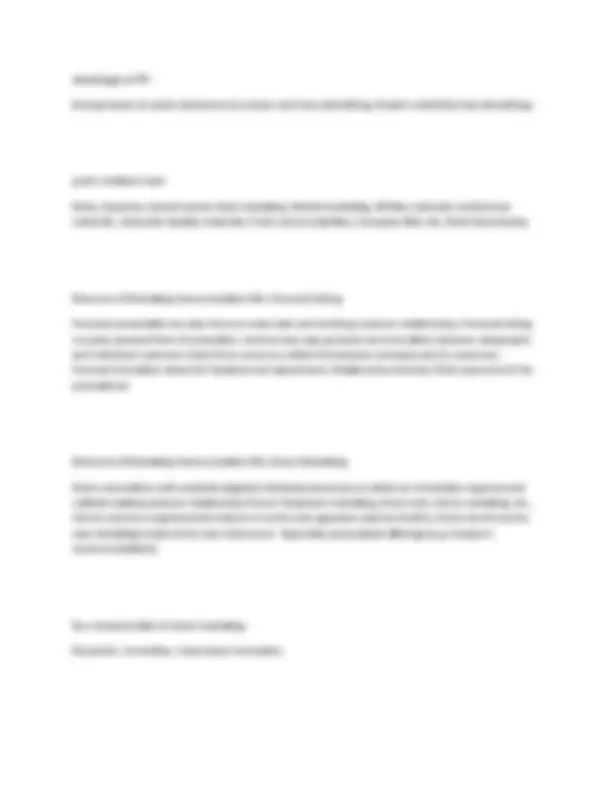
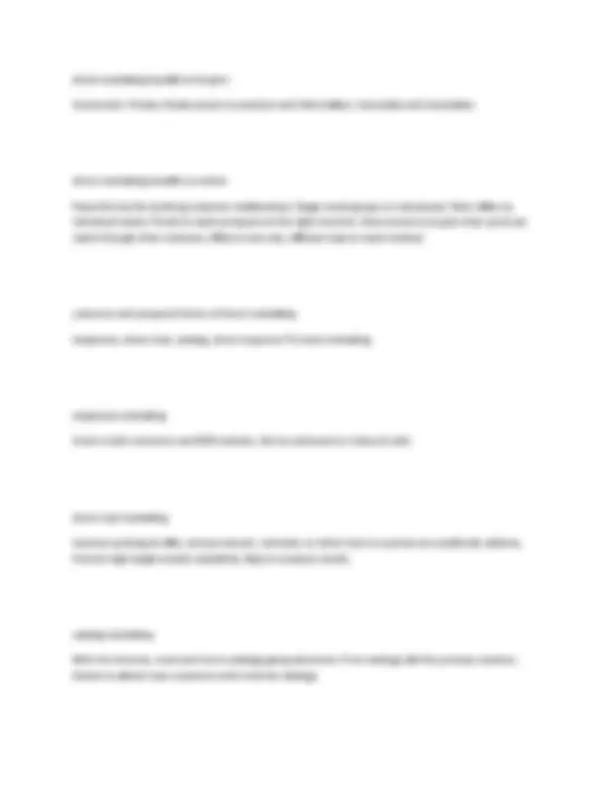

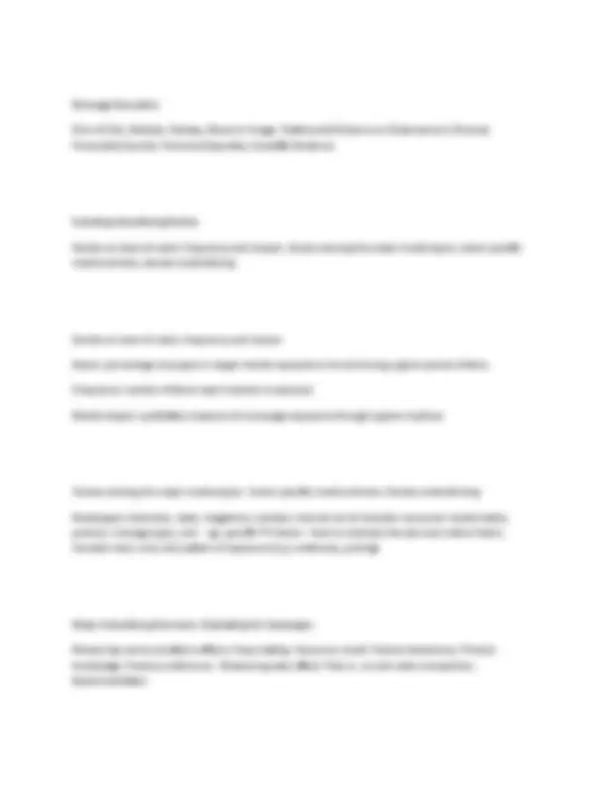

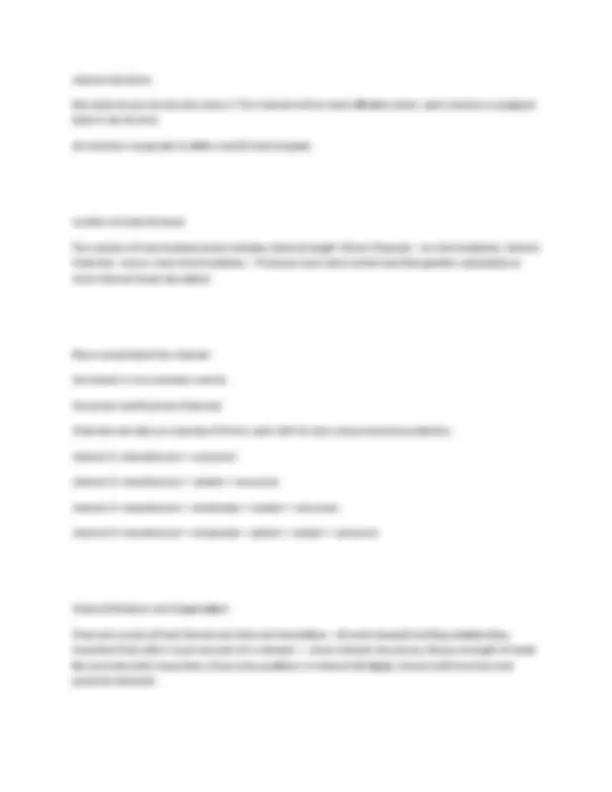
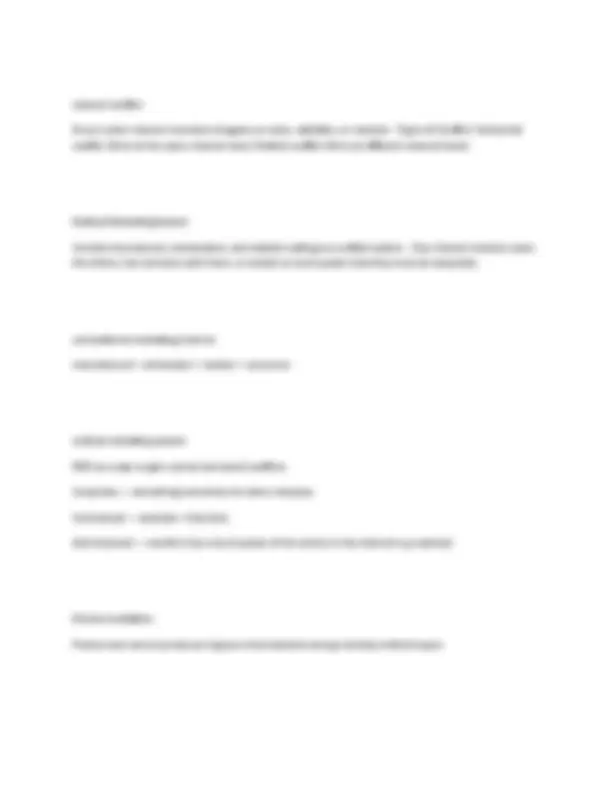



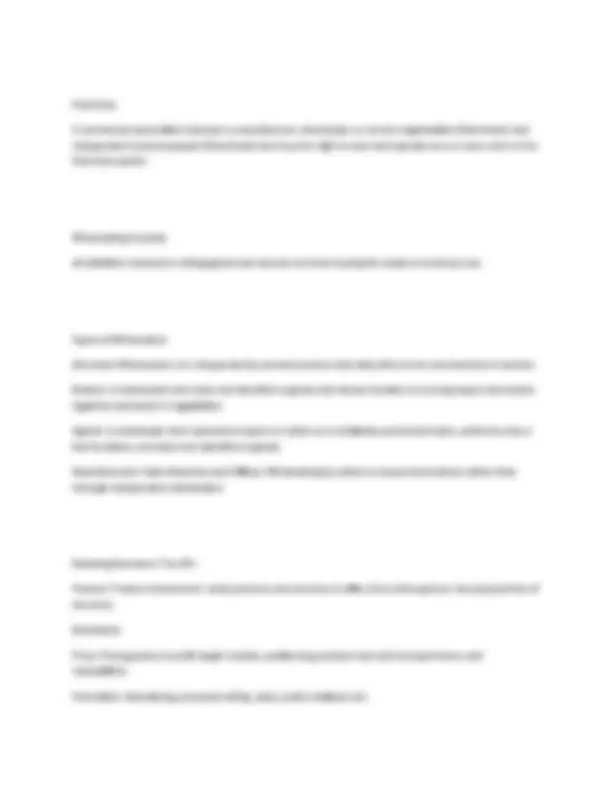



Study with the several resources on Docsity

Earn points by helping other students or get them with a premium plan


Prepare for your exams
Study with the several resources on Docsity

Earn points to download
Earn points by helping other students or get them with a premium plan
Community
Ask the community for help and clear up your study doubts
Discover the best universities in your country according to Docsity users
Free resources
Download our free guides on studying techniques, anxiety management strategies, and thesis advice from Docsity tutors
This document offers a detailed exploration of pricing strategies in marketing, covering various internal and external factors influencing price decisions. it examines different pricing approaches, including cost-based, value-based, and competition-based pricing, with practical examples and analyses of market structures like pure competition and monopolies. key concepts such as price elasticity of demand, break-even analysis, and psychological pricing are also discussed, providing a solid foundation for understanding pricing in a business context.
Typology: Exams
1 / 26

This page cannot be seen from the preview
Don't miss anything!



















price
The amount of money charged for a product or service - The sum of all the values that consumers exchange for the benefits of having or using the product or service.
considerations in setting price
product costs (price floor: no profits below this price)
competition and other external factors: (competitors strategies and prices, marketing strategy, objectives, and mix, nature of the market and demand)
consumer perceptions of value (price ceiling: no demand above this price)
cost-based pricing process
design a good product > determine product costs > set price based on cost > convince buyers of products value
value-based pricing process
assess customer needs and value perceptions > set target price to match customer perceived value > determine costs that can be incurred > design product to deliver desired value at target price
internal factors that affect price decisions
marketing objectives, marketing mix strategy, costs, organizational considerations
Factors Affecting Price Decisions: Internal - Marketing Objectives
Market positioning influences strategy
Other pricing objectives: survival, current profit maximization, market share leadership
Not-for-profit objectives: Partial or full cost recovery, Social pricing
Factors Affecting Price Decisions: Internal - Marketing Mix
Pricing must be carefully coordinated with the other marketing mix elements, Target costing is often used to support product positioning strategies based on price - starts with ideal selling price and then targets costs to meet that price, Price must match distribution strategy as well as media placement strategy for advertising
Factors Affecting Price Decisions: Internal - Costs
types of costs: variable, fixed, total, How costs vary at different production levels will influence price- setting
fixed costs
costs that do not vary with production or sales level
variable costs
Types of markets: Pure competition, Monopolistic competition, Oligopolistic competition, Pure monopoly
Consumer perceptions of price and value: How to measure?, Just noticeable difference
Price-demand relationship: Demand curve, Price elasticity of demand
pure competition
Many buyers and sellers where each has little effect on the going market price
Monopolistic Competition:
Many buyers and sellers who trade over a range of prices
Oligopolistic Competition:
Few sellers who are sensitive to each other's pricing/marketing strategies
Pure Monopoly
Market consists of a single seller
the market and demand
Costs set the lower limit of prices.
The market and demand set the upper limit.
price elasticity of demand
% change in quantity demanded / % change in price
giffen good
applies to inferior products who's demand increases with price due to lack of substitutes - e.g. as price of staple foods like milk and bread increases, consumers are forced to spend more of their income on these products and less on superior products
veblen good
demand and preference for product increases as price increases - e.g Gibson Guitars found an increase in sales as they increased their prices.
3 major pricing strategies:
customer value-based pricing, cost-based pricing, & competition based pricing
customer value based pricing
setting prices based on buyers perceptions of value rather than on sellers cost
cost-based pricing
setting prices based on the costs for producing, distributing, and selling the product plus a fair rate of return for effort and risk
Break-even charts show total cost and total revenues at different levels of unit volume, The intersection of the total revenue and total cost curves is the break-even point, Companies wishing to make a profit must exceed the break-even unit volume.
break-even volume equation
fixed cost / price - variable cost
value - based pricing
Uses buyers' perceptions of value rather than seller's costs to set price, Measuring perceived value can be difficult, Consumer attitudes toward price and quality have shifted during the last decade, Introduction of less expensive versions of established brands has become common.
competition-based pricing
Also called going-rate pricing, May price at the same level, above, or below the competition, Bidding for jobs is another variation of competition-based pricing
market - skimming pricing
Set a high price for a new product to "skim" revenues layer by layer from the market, Company makes fewer, but more profitable sales.
New Product Pricing Strategies: market - skimming pricing
Product's quality and image must support its higher price, Costs of smaller volume cannot be so high they cancel the advantage of charging more, Competitors should not be able to enter market easily and undercut the high price.
New Product Pricing Strategies: market - penetration pricing
Market must be highly price sensitive so a low price produces more market growth, Production and distribution costs must fall as sales volume increases, Must keep out competition and maintain low price or effects are only temporary. Set a low initial price in order to "penetrate" the market quickly and deeply, Can attract a large number of buyers quickly and win a large market share.
product mix pricing strategies - product line pricing
Setting price steps between product line items based on cost differences, customer perceptions, or competitor's price
product mix pricing strategies - optional-product pricing
Pricing optional or accessory products sold with the main product
product mix pricing strategies - captive-product pricing
Pricing products that must be used with the main product,
Services: two-part pricing strategy - Fixed fee plus a variable usage rate
product mix pricing strategies - by-product pricing
Pricing of low-value by-products to get rid of them
Easily copied by competitors, Creates deal-prone consumers, May erode the brand's value, Not a substitute for effective strategic planning, Frequent use leads to industry price wars which benefit only a few firms
Public Policy Issues in Pricing - price-fixing
Competitors cannot work with each other to set prices
Public Policy Issues in Pricing - predatory pricing
Firms may not sell below cost with the intention of punishing a competitor or gaining higher long-run profits or running a competitor out of business.
Public Policy Issues in Pricing - price discrimination
Sellers must charge the price to all customers unless they can justify the difference in price.
Public Policy Issues in Pricing - retail price maintenance
Manufacturers cannot force resellers to charge a specific price
Public Policy Issues in Pricing - deceptive pricing
Cannot advertise a false sale (e.g. if you say it is a price reduction it must in fact be a price reduction)
Public Policy Issues in Pricing - price confusion
Pricing terms must be easy to understand
Integrated Marketing Communications (IMC)
Companies carefully integrate and coordinate its communications to deliver a clear, consistent, and compelling message.
the need for IMC
Conflicting messages can confuse company or brand images - the problem is particularly prevalent when functional specialists handle individual forms of marketing communications independently
marketing communications mix
The mix of advertising, personal selling, direct marketing, sales promotion, and public relations used to pursue advertising and marketing objectives.
carefully blended mix of promotion tools
advertising > personal selling > public relations > direct marketing > sals promotion > advertising >
Push strategy:
trade promotions and personal selling efforts push the product through the distribution channels.
advantages of PR:
Strong impact on public awareness at a lower cost than advertising, Greater credibility than advertising.
public relations tools
News, Speeches, Special events, Buzz marketing, Mobile marketing, Written materials, Audiovisual materials, Corporate identity materials, Public service activities, Company Web site, Event Sponsorship
Elements of Marketing Communication Mix: Personal Selling
Personal presentation by sales force to make sales and building customer relationships, Personal selling is a paid, personal form of promotion, Involves two-way personal communication between salespeople and individual customers, Sales Force serves as critical link between company and its customers, Personal interaction allows for feedback and adjustments, Relationship-oriented, Most expensive of the promotional
Elements of Marketing Communication Mix: Direct Marketing
Direct connections with carefully targeted individual consumers to obtain an immediate response and cultivate lasting customer relationships Forms: Telephone marketing, direct mail, online marketing, etc., Can be used as a supplemental medium or as the only approach used by the firm, Some see this as the new marketing model of the next millennium - Especially personalized offerings (e.g. Amazon's recommendations)
four characteristics of direct marketing
Nonpublic, Immediate, Customized, Interactive
direct marketing benefits to buyers
Convenient, Private, Ready access to products and information, Immediate and interactive
direct marketing benefits to sellers
Powerful tool for building customer relationships, Target small groups or individuals, Tailor offers to individual needs, Timed to reach prospects at the right moment, Gives access to buyers they could not reach through other channels, Offers a low-cost, efficient way to reach markets
customer and prospects forms of direct marketing
telephone, direct mail, catalog, direct response TV, kiosk marketing
telephone marketing
Used in both consumer and B2B markets, Can be outbound or inbound calls.
direct mail marketing
Involves sending an offer, announcement, reminder, or other item to a person at a particular address, Permits high target-market selectivity, Easy to measure results.
catalog marketing
With the Internet, more and more catalogs going electronic, Print catalogs still the primary medium, Harder to attract new customers with Internet catalogs.
other marketing decisions, Can be both direct (e.g. specific behavioral response) or indirect (e.g. attitude change).
classified by purpose in setting objectives:
Inform - Introduce new products
Persuade - Build selective demand
Compare - direct or indirect comparison with competition
Remind - keeps consumers thinking about the product
Major Advertising Decisions: Setting the Budget
Consider several factors when setting ad budgets:
Stage in the PLC, Market share, Level of competition, Ad clutter, Degree of brand differentiation
Budget Setting Methods:
Affordable: level management thinks they can afford.
Percentage of Sales: percentage of current or forecasted sales or as percentage of unit sales price.
Competitive-Parity: match competitors' outlays.
Objective and Task: define objectives, determine tasks required to meet those objectives, estimate costs of performing those tasks.
Major Advertising Decisions: Developing the Ad Strategy
Advertising strategy major elements: creating advertising messages and selecting advertising media - Creative strategy can be driven by message content or media choice, Message and media should be tightly aligned.
advertising challenges
Media fragmentation; Media Costs; Advertising Clutter
creating ad messages
Message strategy, Creative concept, Advertising appeal
message execution
Many execution styles, Tone, format, illustration, headline, copy
Creating the Advertising Message:
Message Strategy: What general message will be communicated to customers. Creative Concept: the big idea that brings the message strategy to life in a distinctive and memorable way.
Advertising appeal should be:
Meaningful: point out important differences and/or attributes
Believable: consumers must believe that the product or service will deliver the promised benefits
Distinctive: tell how the product is better than competing brands
Marketing Channel (Distribution Channel)
set of interdependent organizations involved in the process of making a product or service available for use or consumption by consumer or business users. - Channel choices affect other decisions in the marketing mix, A strong distribution system can be a competitive advantage, Channel decisions often (but do not have to) involve long-term commitments to other firms
channel includes
all the entities involved with making and selling the product, from raw material producers, to sales people in stores.
channel choices affect the 4 p's
product (what can you get to go into product, where can you sell it, what price can you charge for it given that goes into it and what you charge for it, and then what kind of promotions can you use).
why use channels?
The use of intermediaries results from their greater efficiency in making goods available to target markets - Offers the firm more than it can achieve on its own through the intermediaries: Contacts, Experience, Specialization, Scale of operation
Key Functions of Intermediaries
These functions should be assigned to the channel member who can add the most value for the cost - information, promotion, contact, matching negotiation, physical distribution, financing, and risk taking
channel decisions
Not what do you do but who does it: The channel will be most effective when: each member is assigned tasks it can do best,
all members cooperate to attain overall channel goals.
number of channel levels
The number of intermediary levels indicates channel length: Direct Channels - no intermediaries, Indirect Channels - one or more intermediaries -- Producers lose more control and face greater complexity as more channel levels are added.
More complicated the channel:
the harder it is to maintain control.
Consumer and Business Channels
Channels can take on a variety of forms, each with its own unique business problems.
channel 1: manufacturer > consumer
channel 2: manufacturer > retailer > consumer
channel 3: manufacturer > wholesaler > retailer > consumer
channel 4: manufacturer > wholesaler > jobber > retailer > consumer
Channel Behavior and Organization
Channels consist of both formal and informal interactions - all work towards building relationships. Important that a firm is just one part of a network --- show network structures; discuss strength of weak ties and why that's important; discuss key positions in network (bridges); discuss both business and personal networks.